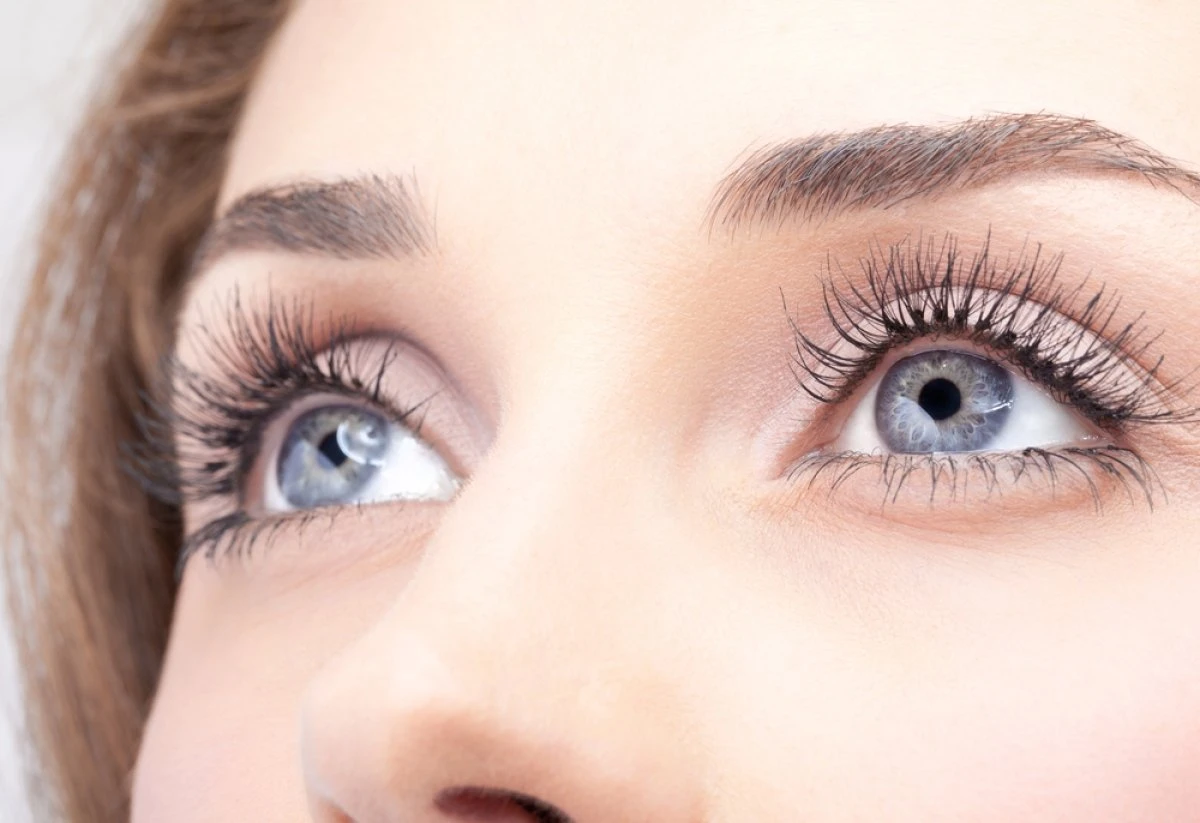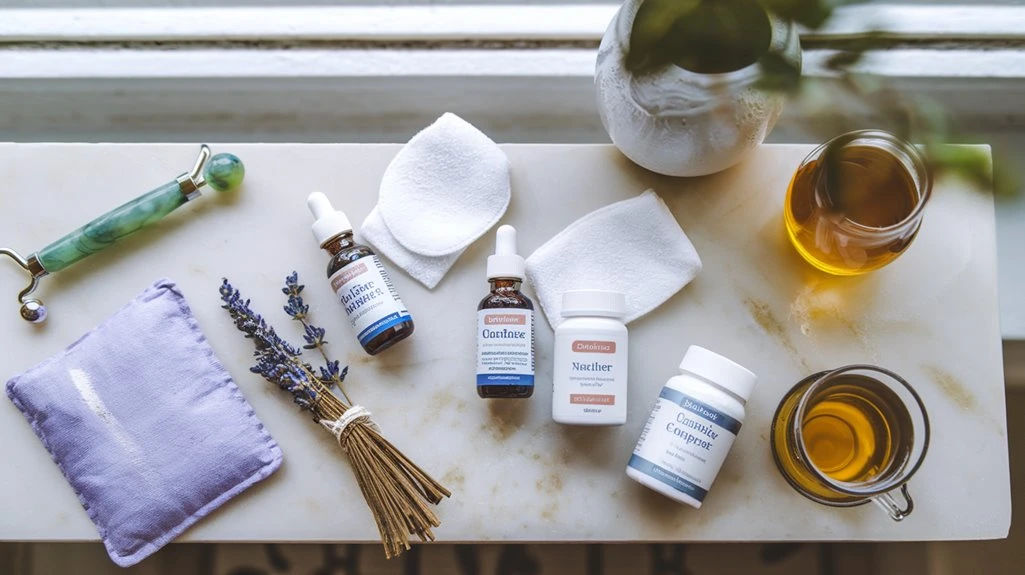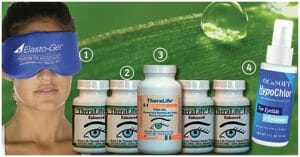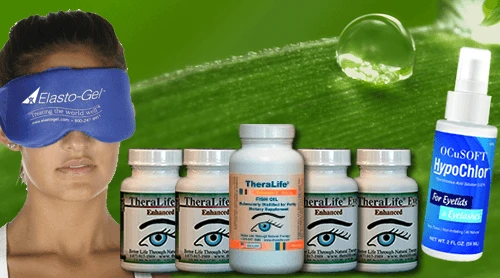TheraLife offers a range of products that provide significant benefits for managing chalazion and other eye-related conditions. Their products focus on holistic and natural approaches to eye health, aiding in effective symptom relief and promoting recovery.
Chalazion management is enhanced with TheraLife‘s products, which emphasize natural healing and prevention. For example, their supplements are designed to support overall eye health, reducing the risk of recurrent chalazion after surgery. TheraLife’s approach includes maintaining proper eyelid hygiene, using hypoallergenic products that prevent inflammation, and employing warm compress techniques to reduce symptoms.
Beyond chalazion, TheraLife provides solutions for conditions like blepharitis, dry eyes, and uveitis. Their products target underlying causes, such as inflammation and eyelid mites, offering comprehensive treatment plans. They also provide dietary and lifestyle recommendations, enhancing the effectiveness of their products.
In addition, TheraLife shares insights on how environmental factors can impact eye health, providing guidance on the best and worst places to live for dry eyes. Their focus on natural treatments, such as anti-inflammatory diets and the use of nature-inspired methods, underscores their commitment to holistic wellness.
Overall, TheraLife’s products and resources empower customers with knowledge and tools to manage eye conditions effectively, promoting long-term eye health and comfort.
All Natural Remedy For Chalazion That Works . When Drops Don’t Work.
Add To Cart
Key Takeaways
- Use antibiotic ointments like chloramphenicol for preventing secondary infections around the chalazion.
- Apply mild topical steroids such as triamcinolone acetonide to promote chalazion resolution within 1-2 weeks.
- Utilize artificial tears to reduce eye irritation and maintain moisture for enhanced healing.
- Incorporate warm compresses 4-6 times daily to reduce inflammation and encourage chalazion healing.
- Maintain eyelid hygiene with hypoallergenic cleansers like OCuSOFT wipes to prevent chalazion recurrence.
Antibiotic Ointments
While chalazia themselves aren’t directly treated with antibiotic ointments, these medications play an important role in managing any secondary infections that may arise. Proper eyelid hygiene can help prevent the recurrence of chalazion and reduce the need for antibiotic ointments. You can rely on the effectiveness of over-the-counter options like chloramphenicol or prescription alternatives such as erythromycin and doxycycline. These antibiotics, when applied topically, act as a prophylactic measure against bacterial infections, guaranteeing the chalazion environment remains sterile.
It is essential to maintain proper eye hygiene by washing your face and removing makeup before bed, as this can prevent both chalazia and styes. However, you’re advised to be vigilant about potential side effects like eye irritation or allergic reactions, which can exacerbate your symptoms.
Monitoring interactions with other medications is vital, as is adhering to usage guidelines to prevent complications. Reporting adverse effects to regulatory bodies guarantees safe use and contributes to understanding antibiotic effectiveness in treating secondary infections.
Pain Relievers
When managing chalazion pain, you can benefit from over-the-counter pain relievers like acetaminophen and ibuprofen, which are effective in alleviating discomfort. Chalazia are caused by blocked oil glands in the eyelid, leading to swelling and irritation. It’s important to choose the right medication by considering factors such as potential drug interactions and personal allergies, ensuring you consult a healthcare provider if necessary. Consistently applying warm compresses can also aid in reducing inflammation and speeding up the healing process. Adhering to dosage guidelines is essential for safety; always follow the instructions on the packaging to avoid adverse effects.
Benefits of Pain Relievers
Pain relievers play a critical role in managing the discomfort associated with chalazion, providing significant relief during both the healing process and post-surgical recovery. Their effectiveness in pain management techniques is evident, as they substantially reduce discomfort without the need for specific types. Over-the-counter options offer a practical solution for short recovery periods after surgical intervention. While they don’t prevent infection, their use post-surgery is invaluable for comfort. Applying warm compresses 4-6 times daily can significantly aid in reducing inflammation and promoting drainage, enhancing the overall effectiveness of pain relievers. Incorporating pain relievers with warm compresses and eyelid massages enhances therapeutic outcomes. This combination therapy not only alleviates pain but supports overall healing. It’s important to adhere to the recommended dosage to avoid complications. Remember, while pain relievers are safe, they should be used cautiously and as directed to guarantee ideal recovery. Utilizing regular eyelid cleansing is also crucial in maintaining hygiene and preventing further complications.
Choosing the Right Medication
Selecting the appropriate medication for managing a chalazion can greatly impact your recovery process. Effective medication selection involves understanding pain relievers’ roles and how they contribute to treatment effectiveness. Ibuprofen is beneficial for its anti-inflammatory properties, while acetaminophen addresses pain without reducing inflammation. If bacterial infection is present, topical antibiotic ointments are essential. For significant swelling, steroid eye drops—though requiring a prescription—are effective. Proper eyelid hygiene is crucial in reducing the risk of styes and chalazia, and maintaining it can aid in recovery. Regular monitoring of chalazion size, color changes, and associated discomfort is crucial for evaluating treatment effectiveness. Always consider concurrent eye conditions and potential medication interactions. Consult a healthcare professional if symptoms persist, ensuring a thorough approach to chalazion management.
Dosage and Safety Tips
To guarantee effective and safe management of a chalazion, adhere strictly to the recommended dosage instructions for pain relievers. For early or mild chalazions, warm compresses can significantly aid in reducing the size and discomfort. Follow precise dosage guidelines: for ibuprofen, take 200-400 mg every 4-6 hours; for acetaminophen, take 325-1000 mg every 4-6 hours. Limit usage to a few days to a week. Consistent application of warm compresses is crucial for better results, ensuring enhanced drainage and inflammation reduction. Integrate pain relievers with warm compresses and eyelid massage for thorough relief. Implement safety measures by monitoring allergic reactions, especially if itching or swelling occurs. Be cautious of drug interactions and avoid overuse to prevent side effects or dependency. Consult a healthcare professional for children’s dosage, during pregnancy, or breastfeeding. If symptoms persist or worsen, seek medical advice to evaluate the need for further intervention.
Anti-inflammatory Eye Drops
When dealing with a chalazion, anti-inflammatory eye drops serve a critical role in reducing inflammation and alleviating discomfort. These drops utilize anti-inflammatory mechanisms to target the swelling associated with chalazia, effectively diminishing its size and associated symptoms. A chalazion usually disappears on its own within a couple of weeks, but using anti-inflammatory eye drops can expedite this process. Eye drop administration typically involves applying tobramycin or tobramycin/dexamethasone formulations, which are evidence-based treatments known for their efficacy. You should administer the drops as directed by an eye care professional, especially if the chalazion persists beyond initial home remedies. While these drops offer significant benefits, they mightn’t suffice for larger or chronic chalazia, necessitating stronger interventions. Always consult a doctor before starting treatment, as prolonged use can lead to side effects and complications. For best results, complement these drops with warm compresses. Practicing good eyelid hygiene is essential for preventing recurrence and supporting the healing process.
All Natural Remedy For Chalazion That Works . When Drops Don’t Work.
Add To Cart
Artificial Tears
Artificial tears provide essential lubrication and moisturization to soothe the affected eye during chalazion healing. They’re effective in alleviating dryness symptoms, reducing discomfort, and promoting a more comfortable recovery process. These solutions are available over-the-counter and can be used multiple times a day as needed to maintain moisture and protect the eyes. Make sure to follow usage directions carefully to optimize benefits while minimizing potential side effects. Chronic dry eyes, often linked to meibomian gland dysfunction, can exacerbate conditions like chalazion, making artificial tears a vital remedy for addressing underlying dryness.
Soothing Eye Moisturization
For individuals dealing with a chalazion, utilizing artificial tears can be an important step in managing symptoms effectively. These drops provide significant eye lubrication, enhancing moisture retention, which is essential in reducing irritation and facilitating healing. By maintaining consistent eye moisture, artificial tears help prevent further swelling and discomfort. Research indicates that their non-invasive nature supports recovery without complicating factors such as additional dryness. Chalazion typically occurs due to a blocked duct in the meibomian glands, leading to the accumulation of secretions. Consider these benefits:
- Reduces Irritation: Artificial tears mitigate eye irritation effectively.
- Enhances Moisture Retention: They improve moisture retention, significant for healing.
- Non-Invasive Treatment: A simple option without invasive procedures.
- Variety of Options: Choose from preservative-free, gel, or drop forms.
- Promotes Healing: Regular use aids in chalazion recovery.
Furthermore, lifestyle adjustments such as using humidifiers, maintaining hydration, and incorporating omega-3 fatty acids in the diet can support overall eye health and aid in recovery. Ensure proper application and consult a doctor if needed.
Relief for Dryness Symptoms
While managing chalazion symptoms, addressing dryness is essential for effective relief and recovery. Artificial tears play a significant role in maintaining eye moisture, alleviating dryness and irritation often associated with chalazion. Chalazion can result from blocked oil glands, leading to discomfort and swelling. Apply artificial tears frequently, especially during warm compress treatments, to optimize relief strategies. Choose between preservative and non-preservative eye drops based on your sensitivity and frequency of use. Non-preservative options are preferable for frequent application to prevent irritation. For persistent dryness, consider gels or ointments offering extended lubrication. Artificial tears can complement other treatments, enhancing overall symptom management. Prolonged screen time can exacerbate dryness, so taking regular breaks can help in managing eye moisture levels. Consult an eye care specialist to select suitable products, especially if underlying dry eye conditions or lifestyle factors like makeup use contribute to your symptoms.
Mild Topical Steroids
Mild topical steroids, particularly triamcinolone acetonide at 40 mg/mL, demonstrate notable effectiveness for resolving chalazia, with success rates ranging from 50% to 95%. This high concentration facilitates efficient topical application, targeting inflammation by inhibiting histiocytes and multinucleated giant cells. Such steroid effectiveness is evident as chalazion resolution typically occurs within 1 to 2 weeks post-treatment. Untreated chalazia may lead to more severe complications, such as preseptal cellulitis, which emphasizes the necessity of effective management. Initial management typically involves conservative treatments such as warm compresses, eyelid massage, and mild topical steroids. However, larger or chronic chalazia might necessitate repeated injections for full resolution.
- Resolution Time: Typically 1-2 weeks post-injection.
- High Concentration: Essential for penetrating encapsulated chalazion tissue.
- Chronic Chalazia: May require multiple doses.
- Depigmentation Risk: Not advised for dark-skinned individuals.
- Combination Therapy: Effective for large or multiloculated chalazia.
Administering corticosteroids requires precision to maximize benefits while minimizing potential side effects.
Eyelid Hygiene Products
In addressing chalazion treatment, eyelid hygiene products play an important role in managing symptoms and preventing recurrence. Effective eyelid cleansing with hypoallergenic cleansers is key.
Opt for products like OCuSOFT medicated wipes or solutions containing natural ingredients such as tea tree oil and hypochlorous acid. These options reduce eyelid inflammation and prevent bacterial colonization while being gentle on sensitive skin.
Apply twice daily with a clean cotton ball or soft cloth for best results. Make certain that tea tree oil is correctly diluted to avoid irritation.
Selecting preservative-free wipes or pads with soothing natural ingredients aids in promoting healing. Hypoallergenic products, including artificial tears and lid wipes, minimize allergic reactions and inflammation, vital for individuals with sensitive skin.
Warm Compress Kits
Warm compress kits are essential tools for effectively managing chalazion symptoms. They offer warm compress effectiveness by reducing inflammation and facilitating drainage from blocked oil glands.
The best application techniques involve using a warm compress 4 to 5 times daily for 5 to 10 minutes, ensuring it’s warm, not hot, to prevent injury.
Kits can include:
- Rice in Sock: Microwave rice in a sock for quick, reusable heat.
- Commercial Products: Options like Bruder Mask and MediViz Eye Mask.
- Hot Water Method: Simple towel soaking technique.
- Microwave Method: Heat a damp towel for convenience.
- Specialized Heating Pads: Designed for targeted eye use.
These kits not only alleviate pain but also help prevent surgical interventions, promoting effective self-care at home.
All Natural Remedy For Chalazion That Works . When Drops Don’t Work.
Add To Cart
Frequently Asked Questions
Can I Wear Contact Lenses While Treating a Chalazion?
You shouldn’t wear contact lenses while treating a chalazion.
Contact lens hygiene is essential, and wearing them can exacerbate chalazion symptoms, causing irritation and possibly spreading infection.
The lenses can harbor bacteria, complicating healing. They might increase inflammation and delay recovery.
Ophthalmologists recommend discontinuing contact lens use until the chalazion resolves.
Instead, monitor your condition closely, apply warm compresses, and follow professional advice to guarantee effective healing.
How Long Do Over-The-Counter Remedies Take to Work?
Amazingly, about 18% of people see complete chalazion resolution within 4-6 weeks using just warm compresses.
When considering chalazion treatment duration, an effective remedy timeline often spans 1-4 weeks. For best results, apply warm compresses 2-4 times daily for 5-15 minutes. Consistency is key.
If there’s no improvement within a few weeks, consult a healthcare professional to assess whether additional treatments like tobramycin are necessary.
Are There Any Side Effects to Using Chalazion Remedies?
You’re considering chalazion treatment options, so it’s essential to understand potential side effects.
Warm compresses might cause burns or skin irritation.
Antibiotic-steroid drops can lead to allergic reactions, skin thinning, or even antibiotic resistance.
Steroid injections carry risks like hypopigmentation and increased glaucoma risk, especially in darker skin tones.
Surgery could result in infection or gland damage.
Always weigh these risks and consult a healthcare professional before starting treatment.
Can Children Use Over-The-Counter Chalazion Treatments?
Approximately 80% of chalazions resolve with proper care.
You can safely use over-the-counter treatments for children, focusing on child safety and treatment effectiveness. Warm compresses and OTC eyedrops are generally safe and effective, provided you supervise their use.
Avoid letting children squeeze or rub the chalazion. Monitor for any adverse reactions, and consult a healthcare provider if symptoms persist or worsen to guarantee the treatment remains effective and safe.
How Do I Know if My Chalazion Is Infected?
To determine if your chalazion is infected, observe symptom identification such as increased redness, swelling, pain, pus discharge, or fever.
If these symptoms are present, infection is likely. Treatment options include using warm compresses to alleviate discomfort and considering antibiotics for bacterial involvement.
In severe cases, seek professional drainage. Maintaining hygiene by washing hands can prevent infection.
Always consult a healthcare provider for a precise diagnosis and tailored treatment plan.
All Natural Remedy For Chalazion That Works . When Drops Don’t Work.
Add To Cart
Conclusion
In managing chalazion symptoms, TheraLife.com offers a range of products that can benefit its customers. Their remedies focus on enhancing eye health naturally, particularly for those dealing with conditions like blepharitis, dry eyes, and recurrent chalazion. TheraLife products are designed to improve eyelid hygiene, provide relief from discomfort, and support the body’s natural healing processes through the use of natural ingredients and supplements.
For instance, TheraLife’s approach to treating chalazion includes the use of their specialized eye-enhancing supplements that aim to reduce inflammation and promote overall eye wellness. The products support the body’s immune response, potentially reducing the recurrence of chalazion and other related eye conditions.
Moreover, TheraLife emphasizes the importance of a comprehensive eye care routine, which includes maintaining eyelid hygiene and using natural anti-inflammatory supplements, to address the root causes of eye conditions rather than just the symptoms. By incorporating their products into a daily regimen, customers may experience more sustainable relief and management of their eye conditions.
Always consult with a healthcare professional to ensure these remedies align with your specific needs. TheraLife provides a holistic approach that complements traditional treatments, aiming to enhance the quality of life for those suffering from eye-related ailments.





